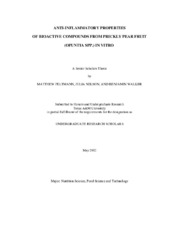| dc.contributor.advisor | Talcott, Susanne U | |
| dc.creator | Nelson, Julia 1989- | |
| dc.date.accessioned | 2015-06-30T14:02:13Z | |
| dc.date.available | 2015-06-30T14:02:13Z | |
| dc.date.created | 2012-05 | |
| dc.date.issued | 2012-05-08 | |
| dc.date.submitted | May 2012 | |
| dc.identifier.uri | https://hdl.handle.net/1969.1/154464 | |
| dc.description.abstract | Prickly pear is a long-domesticated cactus crop that is important in agricultural economies throughout arid and semiarid parts of the world. Secondary plant compounds found in similar consumable fruits and vegetables have been found to possess anti-inflammatory and anti-oxidant properties. Prickly pear fruit has been shown to contain potentially anti-inflammatory compounds as well as anti-oxidant and nutritional properties including betacyanins and betaxanthins from betalains.
Inflammation is a cause of significant, widespread health concern due to its prevalence in multiple disease processes and health conditions including cancer, obesity, and diabetes. Previous studies have suggested prickly pear may possess hypoglycemic and hypolipidemic properties.
In this study, potential for anti-inflammatory activity has been evaluated by measurement of reactive oxygen species generation and anti-oxidant capacity. Inflammation was assessed with quantification and analysis of mRNA, cytokines, and other proteins associated with inflammatory pathways, specifically the NF-kB dependent pathway. | en |
| dc.format.mimetype | application/pdf | |
| dc.subject | anti-inflammatory, prickly pear fruit, HUVEC | en |
| dc.title | ANALYSIS OF ANTI-INFLAMMATORY EFFECTS OF PHYTOCHEMICALS FROM PRICKLY PEAR FRUIT (OPUNTIA SPP.) IN HUMAN CELL CULTURE | en |
| dc.type | Thesis | en |
| thesis.degree.department | College of Agriculture and Life Sciences | en |
| thesis.degree.discipline | Nutrition | en |
| thesis.degree.grantor | Honors and Undergraduate Research | en |
| thesis.degree.name | Bachelor of Science | en |
| dc.type.material | text | en |
| dc.date.updated | 2015-06-30T14:02:13Z | |


